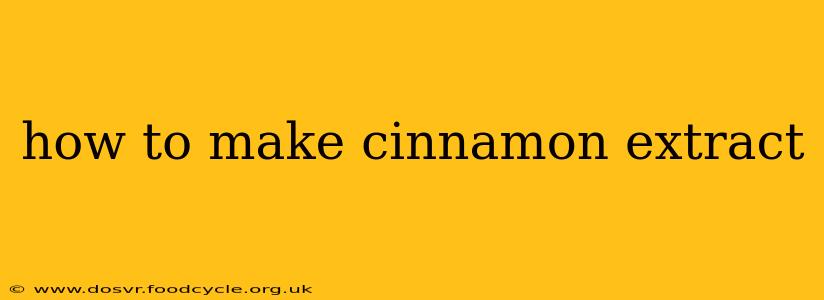Cinnamon extract, with its warm, sweet aroma and distinctive flavor, is a popular ingredient in baking, cooking, and even skincare. While readily available commercially, making your own cinnamon extract offers a rewarding experience, allowing you to control the quality and intensity of the flavor. This guide will walk you through the process, addressing common questions and providing tips for success.
What are the Different Types of Cinnamon and Which Should I Use?
There are several types of cinnamon, each with a slightly different flavor profile and potency. The most common are Ceylon cinnamon (also known as "true" cinnamon) and Cassia cinnamon. Cassia cinnamon is more widely available and generally more affordable, possessing a stronger, more pungent flavor. Ceylon cinnamon is milder and sweeter. For extract, Cassia cinnamon is generally preferred due to its stronger flavor, which will translate better into the finished product. However, you can experiment with Ceylon if you prefer a more subtle taste.
What Ingredients Do I Need to Make Cinnamon Extract?
To make cinnamon extract, you'll need just a few simple ingredients:
- Cinnamon sticks: Choose high-quality cinnamon sticks, preferably Cassia. The amount will depend on the desired strength and quantity of extract. A good starting point is about 1 cup of sticks.
- High-proof alcohol: Vodka or everclear (at least 80 proof, or 40% ABV) is ideal. The alcohol acts as a solvent, extracting the flavor compounds from the cinnamon.
- Glass jar: Choose a clean, airtight glass jar to store the extract during the infusion process.
How Long Does it Take to Make Cinnamon Extract?
The process of making cinnamon extract requires patience. Infusion typically takes anywhere from 4-8 weeks, allowing the alcohol to fully extract the cinnamon's flavor and aroma. The longer you let it infuse, the stronger the flavor will be, but after 8 weeks, the return on extended time diminishes. You can check the flavor after 4 weeks and let it sit longer if needed.
How to Make Cinnamon Extract: A Step-by-Step Guide
- Prepare the Cinnamon: Break the cinnamon sticks into smaller pieces to maximize surface area, aiding in better extraction.
- Combine Ingredients: Place the broken cinnamon sticks in the glass jar. Pour the alcohol over the cinnamon, ensuring all the sticks are submerged. Leave about an inch of space at the top of the jar.
- Seal and Infuse: Tightly seal the jar with a lid. Store the jar in a cool, dark place away from direct sunlight.
- Shake Regularly: Shake the jar gently once or twice a week to keep the cinnamon evenly distributed and promote proper extraction.
- Strain and Filter: After 4-8 weeks, carefully strain the mixture through a cheesecloth or fine-mesh sieve lined with a coffee filter. This will remove all cinnamon pieces, leaving behind a clear, concentrated extract.
- Bottle and Store: Pour the filtered extract into a clean, airtight bottle. Store in a cool, dark place. Your homemade cinnamon extract can last for several years.
How Much Cinnamon and Alcohol Should I Use?
The ratio of cinnamon to alcohol is a matter of preference. A good starting point is 1 cup of cinnamon sticks to 1 liter of high-proof alcohol. You can adjust this based on your desired strength. More cinnamon will lead to a stronger, more intense flavor.
What are the Benefits of Making Cinnamon Extract at Home?
- Control over Quality: You can choose the type and quality of cinnamon used, ensuring the best possible flavor.
- Cost Savings: Making your own extract is often cheaper than buying commercially produced versions.
- Customization: Adjust the strength and flavor profile to your liking.
Can I Use Other Types of Alcohol to Make Cinnamon Extract?
While high-proof vodka or everclear is recommended for its neutral flavor and high alcohol content, you can experiment with other types of alcohol, such as bourbon or rum. However, be aware that these will impart their own flavor to the extract.
How Can I Use Homemade Cinnamon Extract?
Homemade cinnamon extract can be used in a variety of ways, just like its store-bought counterpart:
- Baking: Add it to cakes, cookies, breads, and other baked goods.
- Cooking: Use it in sauces, desserts, and savory dishes.
- Beverages: Add a drop or two to coffee, tea, or hot chocolate.
- Skincare: Some people use diluted cinnamon extract in skincare products, though more research is needed to confirm benefits. (Always test on a small area first!)
Making your own cinnamon extract is a simple and rewarding process. With a little patience, you can enjoy the rich, warm flavor of homemade cinnamon in all your favorite recipes and creations. Remember to always prioritize safety and handle alcohol responsibly.
